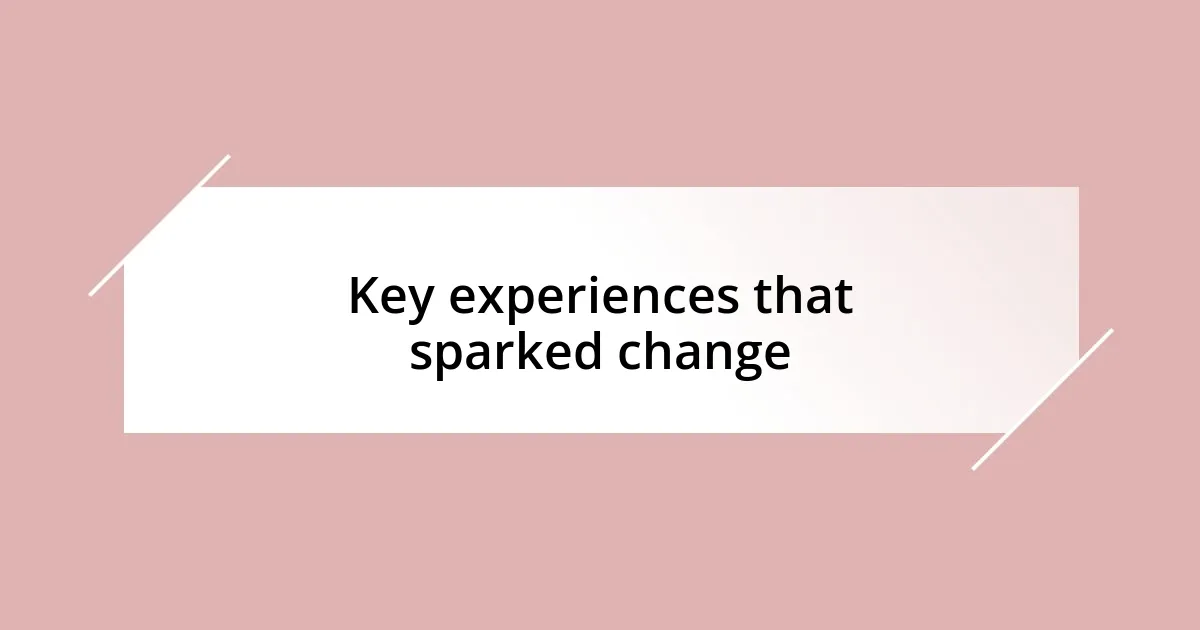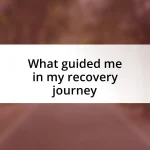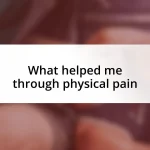Key takeaways:
- Attending a guided meditation retreat led to an emotional catharsis, highlighting that healing is a non-linear process.
- Embracing vulnerability fostered deeper connections and resilience, demonstrating that sharing struggles can create supportive environments.
- Incorporating practices like meditation, journaling, and yoga provided essential tools for emotional processing and personal growth.
- Sharing personal experiences with others inspired connection and encouraged communal healing, emphasizing the power of storytelling.

Defining my healing journey
Defining my healing journey has been a process of peeling back layers of pain and understanding what truly fuels my spirit. I remember a time when I felt overwhelmed by grief, and it was only through journaling my thoughts that I began to identify the emotions I had buried deep inside. Have you ever felt an unshakeable weight on your chest, yet struggled to pinpoint its source? That sensation spurred me to dive deeper into my own psyche.
One pivotal moment in my journey was when I attended a guided meditation retreat. I hadn’t anticipated the flood of emotions that surfaced—joy mingled with sorrow, creating an unexpected catharsis that was both terrifying and liberating. I often reflect on how these raw experiences shaped my understanding of healing; it’s not always linear, is it? Rather, I found that the path can twist and turn, often revealing unexpected lessons.
As I began to embrace vulnerability, I discovered the importance of community. Sharing my struggles with friends and hearing their stories created a profound sense of connection. Isn’t it remarkable how our shared experiences can foster healing? Each time I reached out, I found that my journey continued to evolve, teaching me that healing thrives on openness and compassion, both for myself and others.

Key experiences that sparked change
Sometimes, the most profound shifts come from seemingly small moments. I’ll never forget the day I stumbled upon an old photograph of myself, laughing and carefree. It struck me deeply because I realized how much I had lost track of that version of me during my struggles. This moment acted like a mirror, reflecting not just what I had been through but what I could reclaim. It ignited a desire in me to reconnect with that joy, fueling my journey forward.
Key experiences that sparked this change included:
- My grandmother’s passing: Attending her memorial opened a floodgate of memories and feelings, compelling me to confront unresolved grief that I had pushed aside.
- Finding a mentor: This person guided me towards holistic healing practices, introducing me to journaling in a more meaningful way.
- A random conversation with a stranger: They shared their own story of resilience, which inspired me to share mine. It was enlightening to realize that these narratives can connect us, often revealing paths to healing we hadn’t considered.

Embracing vulnerability in healing
Embracing vulnerability has played a crucial role in my healing process. Initially, I feared that revealing my true self would lead to judgment or rejection. I remember the first time I shared my struggles during a small group session—my voice trembled, and tears rolled down my cheeks as I spoke. However, the warm responses I received reminded me that vulnerability is often met with understanding, creating a safe space for growth and connection. Have you ever felt the liberation that comes with expressing your authentic self? I certainly have, and it’s made all the difference.
In my experience, embracing vulnerability cultivates resilience. I think back to a time when I wrote an open letter to my future self, detailing my fears and aspirations. Putting my insecurities into words felt daunting but ultimately freeing. It was as if I was releasing a weight I had carried for too long. This practice taught me that vulnerability isn’t a weakness; it’s a source of strength—a way to confront my fears head-on while inviting others to do the same.
Moreover, sharing my journey with others has illuminated the universality of our struggles. I recall a heartfelt conversation with a close friend who revealed her own battles with anxiety. In that moment, we both acknowledged our vulnerabilities, and it was transformative. It reminded me that embracing vulnerability fosters empathy, forging deeper connections that are vital for healing. Isn’t it fascinating how our stories can intertwine and support one another?
| Embracing Vulnerability | Resistance to Vulnerability |
|---|---|
| Promotes healing through connection and support | Creates isolation and emotional pain |
| Encourages self-expression and authenticity | Stifles personal growth and resilience |
| Fosters empathy and understanding | Perpetuates misunderstanding and judgment |

Practices that supported my growth
One of the most significant practices that supported my growth was incorporating daily meditation into my routine. I vividly remember the first time I sat in silence, my mind racing with thoughts that felt overwhelming. However, after just a few minutes, I noticed that as I focused on my breath, those chaotic thoughts began to fade. Meditation became my safe haven—a place where I could observe my feelings without judgment. Have you ever felt that instant calm wash over you when you finally step back and breathe? For me, meditation wasn’t just about stillness; it was about re-establishing my connection with myself.
Another transformative practice was journaling. I decided to write down my innermost thoughts and feelings during moments of despair. Initially, it felt like I was pouring my heart onto the pages during a storm. Yet, those pages became a canvas for my healing. I remember re-reading a particularly raw entry months later, and it was like talking to an old friend. Each word reflected how far I had come. Isn’t it amazing how documenting our struggles can provide clarity? Journaling taught me to recognize patterns in my emotions, which helped me navigate through the uncertainties of life with more confidence.
Lastly, engaging in physical movement, such as yoga, has profoundly impacted my journey. At first, I merely thought of it as exercise, but over time, I realized it was much more than that. I still recall a session where, as I moved through poses, I unexpectedly started to cry. It was a release, a shedding of layers I didn’t even know I was carrying. Have you ever experienced a moment in motion that turned into an emotional breakthrough? That day, I learned that movement could be a powerful way to process feelings. Integrating practices like yoga into my life not only strengthened my body but also deepened my emotional resilience, allowing me to flow through challenges with grace.

Overcoming obstacles during recovery
During my recovery, I faced countless challenges that tested my resolve. I vividly recall a day when I felt overwhelmed by the thought of relapsing. I had this sinking sensation in my stomach, a mix of fear and doubt. Instead of succumbing to those feelings, I decided to confront them directly. It was my first real attempt to embrace adversity as part of the journey. Have you ever felt that surge of determination when faced with something daunting? For me, it was a wake-up call reminding me of my strength and capability.
There were times when external circumstances added unexpected hurdles to my recovery path. A significant turning point came when a close friend unexpectedly distanced themselves from me. Initially, I felt abandoned and lonely, grappling with feelings of worthlessness. However, I chose to view this as an opportunity for personal growth rather than a setback. I started focusing on self-compassion and learned the art of creating boundaries in relationships. This experience taught me that overcoming obstacles isn’t just about pushing through; it’s often about re-evaluating our surroundings and nurturing the right connections.
As I navigated through each obstacle, I realized the importance of community support. I remember attending a workshop where participants shared their own battles. Listening to their stories was almost like looking in a mirror. I felt an overwhelming sense of unity in our struggles. Have you ever found comfort in the collective experiences of others? For me, that was a pivotal moment—recognizing I wasn’t alone in my challenges. It has since motivated me to reach out and support others in their healing, reinforcing the idea that together, we can overcome anything.

Lessons learned through my journey
One key lesson I learned through my journey was the power of vulnerability. I used to think that showing my emotions made me weak, but I discovered it was actually a source of strength. I remember a moment when I reluctantly shared my struggles with a trusted friend. The relief I felt afterward was palpable; it marked the first time I understood that being open about my feelings could foster deeper connections. Have you ever felt that weight lifting off your shoulders when you finally let someone in? That experience created a ripple effect, encouraging me to embrace vulnerability as a path to authentic relationships.
Another poignant lesson was about the significance of patience, especially with myself. I had an intense need for quick results—a trait that often led to frustration. In my eagerness for healing, I jumped from one practice to another, hoping to find a magical solution. However, I vividly recall a day when, after weeks of effort, I still felt stuck. It was a turning point when I realized healing is not a linear process; it’s filled with ups and downs. Have you ever noticed how sometimes progress feels invisible? That day taught me that allowing time for growth is just as crucial as the actions I take.
Finally, I learned the beauty of gratitude in my healing process. There were days when the darkness seemed impenetrable, and I struggled to find the light. During one particularly challenging week, I forced myself to write down three things I was grateful for each evening. Surprisingly, even the smallest moments—like a warm cup of tea or a friend’s smile—started to brighten my perspective. Have you ever tried focusing on gratitude even when everything felt heavy? That practice shifted my mindset, reminding me that even in the toughest times, there are always glimmers of hope waiting to be acknowledged.

Inspiring others with my story
Sharing my story has been one of the most fulfilling aspects of my healing journey. I’ll never forget the first time I spoke openly about my struggles at a local support group. The room was filled with compassionate listeners who nodded and smiled, and it struck me how powerful my vulnerability was in connecting with others. Have you ever noticed how sharing your scars can inspire those around you? That moment anchored my belief that our stories have the capacity to foster healing, not just for ourselves but also for others.
Along the way, I’ve realized that my experiences can serve as a lighthouse for someone else navigating through their own storm. One particular instance stands out: a young woman approached me after a workshop, tears in her eyes, expressing how my words resonated with her heart. At that moment, I understood that each story, including mine, has the potent ability to light the way for others. Don’t you feel a sense of purpose when you realize your struggles can empower someone else? It’s as if every hurdle I faced became a stepping stone not just for myself, but for others yearning for hope.
Moreover, sharing my journey has not only provided others with encouragement but has also reinforced my growth. After I posted about my healing milestones online, I was surprised by the outpouring of messages from people who felt inspired. Their gratitude reminded me that vulnerability is infectious; it encourages those around us to open up and embrace their own journeys. Have you experienced the profound ripple effect of simply being authentic? Every time I inspire even just one person, I’m reminded of the interconnectedness of our healing journeys, and it fuels my passion to keep sharing.












